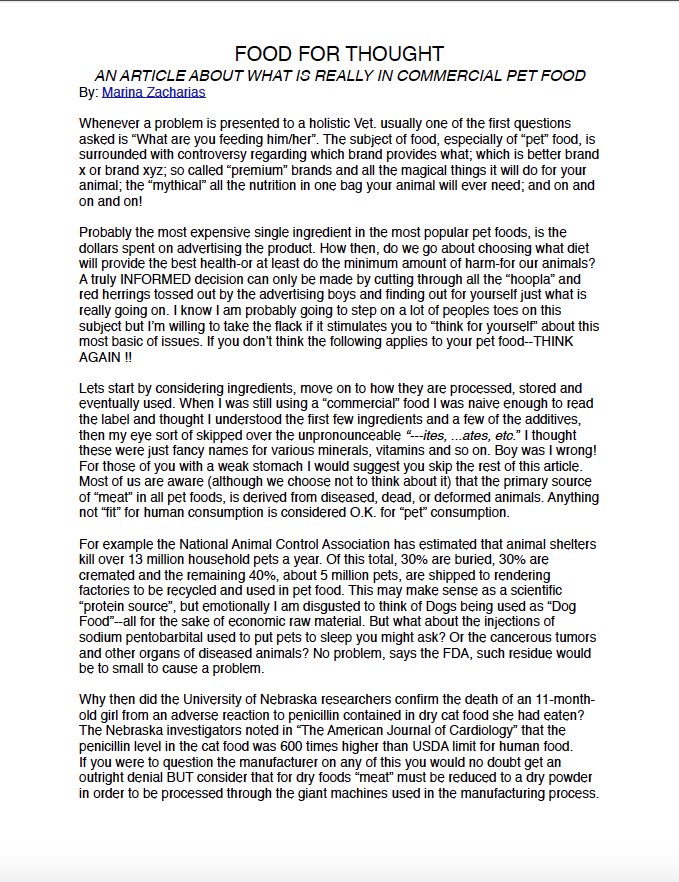Why Should You Naturally Rear Your Dog?
The Natural Rearing Diet is easily prepped, takes little time and the nutrition level is significantly superior to commercially manufactured, processed dog food.
This is particularly significant for those who claim to have little time to feed a dog, especially those with families. It is undemanding and quick, oftentimes faster than preparing our own meal. See my video demonstrations.
Big Money: In 2020, Americans spent nearly forty (40) billion dollars on pet food! Pet food is a hugely profitable business and these pet food manufacturers do not want to lose your money.
According to PetFoodIndustry.com, the World’s Top Ten Pet Food Companies are
Mars (Pedigree)
Nestle Purina
Hills
JM Smucker (Rachel Ray Nutrish & Nature’s Recipe)
General Mills (Blue Buffalo)
Diamond Pet Foods (Taste of the Wild)
Simmons Pet Food
Alphia, a private label pet food, a.k.a. store brands.
Unicharm (Japanese pet food)
Thai Union Group
It goes without saying that the impact of calories and protein levels are entirely different when comparing fresh raw foods to commercially manufactured dog foods. Fundamentally, natural diets contain nature’s probiotics, antioxidants, minerals and nutrients, all vital components in maintaining vigor.
The vast number of American dog owners are bombarded with food choices on television, supermarkets and at specialty "big box" pet stores. Dog owners are constantly advised by apprentice employees working in big box stores as to what brand food they should be feeding, the amounts and so forth.
A large segment of the nutritional advice disseminated by both aforesaid employees and veterinarians is incorrect. Food is a basic sustenance but the nutrient factor is often disregarded or ignored entirely.
The majority of people are unaware that the average medical student receives only 20 hours of nutritional schooling during their studies to obtain a medical degree.
This is true in both human and veterinarian medicine and speaks volumes as to the levels of concern and respect our scientists have for quality nourishment. The truth is that a considerable amount of commercial dog food is substandard sustenance. Even more, the lesser expensive and budget brand dog foods are causing health issues due to poor quality ingredients, crude fiber, and digestibility.
Trans Fats
The durability of fast food as well as commercial dog food is due to preservatives and trans fatty acids. Trans fats extend shelflife, it is great for the company and profits, but it is not good for mammals bodies.
According to the Small Animal Clinical Nutrition, 5th Edition, by Mark Morris,
"High digestibility yields more available nutrients for passive or active transport in intestinal absorption. Another benefit of increased digestibility is less food is needed to meet a pet’s energy and nutrient requirements. Accordingly, high digestibility reduces food costs such that a pet food that appears more expensive to purchase on a unit price basis may actually be a better value than less expensive foods with lower digestibility and caloric density.
The primary determinants of digestibility are differences in ingredient selection and processing. For example, undercooked carbohydrates markedly reduce digestibility. The undigested residue can also alter the pH of intestinal chyme and may produce osmotic effects expressed as decreased stool quality and diarrhea (Schunemann et al, 1989)."
Average Americans are ignorant about the sourcing of dog food ingredients as well as the complete list of the items combined to produce many commercial dog food products. Most people would be horrified if they knew the facts. However, Americans prefer not to know so that they can continue going on with their frantically busy lives. The aversion to the truth is comparable to our own sustenance and foodstuffs we eat. We do not want to see a video of cows or pigs being inhumanly treated at the slaughterhouses or how chickens are raised in mass industrial facilities. We just want to buy the food without feeling guilty.
There simply is not enough space for me to discuss details on this very necessary subject. I respect my friend’s opinions and their feeding methods accepting that many of us have divergent views; we agree to disagree. Having said this though, I am usually left bewildered after my conversations with inexperienced dog owners who contact me seeking my advice about diet or other health issues their dogs are experiencing. Many times after I discuss their dog’s diet and determine there is a lack of quality nutrition, most people remain unyielding claiming they do not have time to prepare their hound's food. Often they profess they are very busy and could not possibly take the time to assemble their dog's dinner of raw ground beef, liver, and supplements or their breakfast cereal grains in the morning.
"How do you manage to feed yourself if you do not have ten minutes to feed your much-loved companion?"
I find it especially baffling as many of these people have families with children, and I am puzzled as to what diet they themselves are subsisting on every day.
Canines eating a raw meat diet digest their foods within two to four hours. This ideal digestive process is significantly faster than a dog who is fed commercial dry food -- food that typically is carbohydrate-heavy. The typical digestive or processing time for a dog eating commercial dry food is over the course of eight to twelve hours because canines do not have the same enzymes as humans. Thus, they can only process carbohydrates very, very slowly. The vicious cycle is that due to a wolfhound’s size, he needs more food and nutrition than does a large or small dog. As a result, the amount of food in each of his meals will be more considerable and when dealing with carbohydrate-heavy foods, this can be risky. Thus, a wolfhound consuming commercial dry dog food should be fed a minimum of twice daily, not once daily, so as to minimize the substantial quantity of food sitting in his stomach cavity.
Another downside of feeding commercial dry dog foods is the manufacturing process. They are mass produced either by an extruded method or pelleted process. The former is very concerning because this method of processed food, while in the stomach, expands. Commercial dog food ordinarily swells and enlarges when warm or hot water is added. We never want a dog food to expand in a wolfhound’s stomach, practically fermenting and producing heat. In my opinion, the longer the foodstuff remains in the stomach, the greater the risk for bloat. I naturally rear my hounds to achieve ideal pH balance in their guts which I feel is another influential factor in bloat.
Lastly, and very importantly, reducing total stress cannot be overemphasized. I minimize stress in my hounds lives, especially before and after feeding times.
Stress in canines is similar to that of humans, their adrenal glands produce cortisol, a stress hormone that attempts to cope with environmental factors, illness or injury. I cannot count how many well-known breeders of different dog breeds have had their dogs die from Bloat resulting from stress. Stress from disturbing, taxing situations arising from travel, either by air or car; sudden changes in living quarters, upsetting new accommodations, stressful environments, the list goes on. Wolfhounds, in particular, are a breed that is quite habitual, they thrive on established routines. That is not to say that they do not like going for car rides, occasional dog shows, long walks, or vacations with the family. However, feeding at all different times of the day, shipping a wolfhound via airline cargo, boarding in a kennel, sending a wolfhound off with a professional dog handler, or having constant family agitation and loud disorder in their home life are just a few situations that can cause considerable disruption and stress in his or her life. Notably, of grave concern are before and after feeding times.
An excited wolfhound will consume their food too quickly. They will gulp it down which introduces air into the stomach. Generally, canines can alleviate gas or excess air by burping, but in cases of bloat, the dog is unable to expel this gas and air. As a consequence, pressure mounts and the stomach dilates abnormally and begins to twist. Phase One of GDV is beginning and whose signs every wolfhound owner and caregiver must be instructed to look for in order to save the hound’s life.
Superior quality from a natural rearing diet consisting of raw meats, vegetables, and fruit, along with all the other high-grade additives discussed on my Nutrition Page, has tremendous benefits besides short digestive times. In accordance with my own extensive feeding experience, I am left with no doubt that my hounds have stronger immune systems which enable them to better resist parasites, diseases, and viruses. Additionally, they have overall greater fitness or health, vigor, and ability.
As an example, one of my hounds Darley had fought an aggressive, malignant gastrointestinal stromal cancer surviving severe peritonitis and major abdominal surgery for resection of a massive tumor. Her surgeon could not possibly remove all the infected nodules due to the extent of the peritonitis, thus, they remained in her. This major surgery usually requires two to three days hospital stay, however, within one hour after waking from her operation with a nearly 14-inch incision resembling a zipper, she was up on her feet attempting to escape her recovery pen. She was home by the following afternoon with a prognosis of three months without chemotherapy or 12 months with chemo.
I decided against both of these options. She fought and survived with excellent quality of life as I utilized homeopathic medicines, along with Dr. Oglive Cancer Diet for nearly two years finally passing on as the cancer mass re-grew, albeit at a slower rate. Her remarkable achievements and journey are due to fitness, both genetic and nutritional.
In closing, I receive numerous inquiries from people regarding nutrition, and am happy to answer fundamental questions. However, many queries I receive ask how much they should feed their dog. It is clear these people did not spend the time nor effort to purchase and read the recommended book(s) and they just want answers. Rather, they seek instant gratification and are not interested in putting in any effort. For these people, I will not provide any measurements and weights and will only refer them to the recommended books for answers.
Best wishes and luck!








